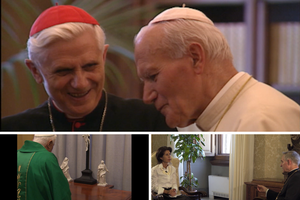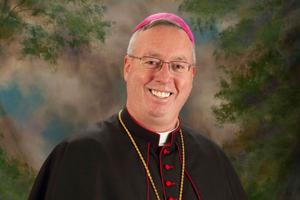Perpetuating Padre Pio’s Mission
Learn about the work of the Saint Pio Foundation

DEVOTEES OF ST. PIO. From left to right, Luciano Lamonarca, Archbishop Timothy Broglio and actor Joe Mantegna at the foundation’s award ceremony on May 21, 2015. Courtesy of the Saint Pio Foundation
Once a year, “we visited there with my mother when she was still alive,” said Luciano Lamonarca, an Italian opera singer, of San Giovanni Rotondo. The Italian town is where St. Pio of Pietrelcina — whose feast day is celebrated Sept. 23 — lived for many years. He died at the Capuchin monastery there.
Ever since those visits, Lamonarca has had a great devotion to Padre Pio.
When the Puglia native came to the United States in 2008, he saw groups trying to preserve the legacy of Padre Pio, but he believed much more could be done to promote this saint.
So he founded the Saint Pio Foundation in 2014.
Recalling those visits to San Giovanni Rotondo, Lamonarca said, “The hospital was one of the miracles that inspired us. We were well aware of the hospital and familiar with the leadership of the hospital, as well as the Capuchin monks of this area.”
The hospital he refers to is Casa Sollievo della Sofferenza, Home for the Relief of Suffering, which St. Pio founded. Also known as the Hospital of Padre Pio, it opened in 1956 and today is under the Holy See’s control; considered a marvel, it offers up-to-date care of the sick in a facility of 1,000-plus beds.
“The hospital is still considered one of Padre Pio’s major miracles,” Lamonarca said, “and, of course, we made a vast donation to the hospital [through the Saint Pio Foundation]. This is one of our goals.”
Pio’s Legacy
The Saint Pio Foundation’s “mission is to promote the legacy of St. Padre Pio,” said Lamonarca, the president and CEO. This means learning more about the life, holiness and spiritual charism of this saint, including sharing Pio’s vision of serving “those in need of relief of suffering.”
As Lamonarca explained, “I like to say we bring relief from suffering in the name of Padre Pio.”
Goodwill ambassadors make the mission and goals known far and wide, including Tony Award-winning actor Joe Mantegna. Mantegna was one of the recipients of the annual “Saint Pio Award,” as was actor Gary Sinise, an Emmy and Golden Globe winner. The award recognizes those who have made outstanding contributions to, and are extraordinary examples in, “providing relief from suffering to those in need.”
And among friends of the foundation is Father Guglielmo Lauriola, a spiritual son of Padre Pio.
The foundation is known to the Vatican. This past spring, a delegation of the Saint Pio Foundation was in Rome on May 3 “to participate at the general audience, where we received the blessing,” Lamonarca said. “We do count on meeting privately with Pope Francis, perhaps next year.”
There is great devotion to Padre Pio in America, Lamonarca explained. “Without America, very few of the projects Padre Pio started could be done.”
Many people don’t know that military veterans started to promote Padre Pio while he was still alive when they came back to America after serving in World War II. Large numbers of veterans who were stationed in Italy, especially in the towns and areas near Padre Pio, began attending his Masses, learned of his miracles — some experiencing miracles themselves — and brought the stories and devotion back with them.
“After that, there was a big increase in people coming and knowing about him,” Lamonarca said.
Consequently, the foundation sells the book Padre Pio and America, and Mantegna and Sinise have been honored because of their tremendous work with veterans. In addition, Archbishop Timothy Broglio of the Archdiocese for the Military Services is on the foundation’s military advisory committee.
And the religious advisory board numbers American prelates, with two cardinals, including Cardinal Edwin O’Brien, grand master of the Equestrian Order of the Holy Sepulchre of Jerusalem, and several archbishops and bishops, including Archbishops Jerome Listecki of Milwaukee and Jose Gomez of Los Angeles.
One of this year’s Padre Pio Award recipients is Judge Daniel Caruso of the Fairfield Probate District Court in Connecticut.
“I didn’t have that much knowledge of Padre Pio,” explained Caruso, “and the foundation asked me to receive the award. Since then, I’m learning more about him and the goals of the foundation: to spread his charism and good works and to bring it closer to the people of this area. It makes me very proud.”
Caruso has come into contact with a “number of people who shared their personal stories of how Padre Pio interceded and brought comfort or healing or caring into their own lives — people who had personal devotion, those whose members of the family had visited him in person, those who had prayed to him and how things worked out. That was something I had never experienced before,” he said.
“It was most amazing and encouraging,” he concluded, “and it gives more evidence for being involved” and spreading the word, “and then we’re going to let St. Pio and God take the rest.”
Now and Then
Right now, the Saint Pio Foundation gives the funds it raises in some grants to local charities in the name of Padre Pio here in the United States, to the town of Pietrelcina where the saintly friar was born and to Casa Sollievo della Sofferenza. Lamonarca noted that the foundation is also committed to support the Capuchins at San Giovanni Rotondo.
Among long-term goals, according to Lamonarca: “We hope to build a clinic within an existing Catholic hospital, much like that hospital by Padre Pio, and to name a wing in the hospital in Padre Pio’s honor. That means many people will become familiar with Padre Pio.”
In just over two short years, the foundation is already active in five states, from the East to West Coasts, with plans for more states to come.
Bishop Frank Caggiano of the Diocese of Bridgeport, Conn., is vice chairman of Saint Pio Foundation’s religious advisory committee.
“I always had a tremendous devotion to Padre Pio from when I was a boy, and my mom did, too,” Bishop Caggiano explained. “In many ways, it’s wrapped up with the mystery of God’s love and his mercy.”
He brought up the gift of spiritual healing through the repentance of sin and the sacramental forgiveness of sins, of which Padre Pio “was a great advocate,” he told the Register. “And also the corporal works of mercy, dealing with the sick and infirm, and showing them God’s love and mercy tangibly.”
Bishop Caggiano tied this into the Saint Pio Foundation’s goal to promote the works and spirituality of Padre Pio, “particularly the works of mercy and charity to the sick and those who are the outcasts, those that society will not embrace.”
His role and that of the other bishops on the board, he said, is to foster the mission of Padre Pio. He sees much going into the foundation’s robust plans.
“Padre Pio is the saint of our own times, like Mother Teresa and John Paul II,” Bishop Caggiano reflected. “The Lord has given us this saint to teach us an important lesson — to make real his merciful love, the charity of God’s heart, and Padre Pio is exemplary in that. The foundation is going to foster that, and I will be there to help them, as well.”
Joseph Pronechen is a
Register staff writer.
INFORMATION
SaintPioFoundation.org
















